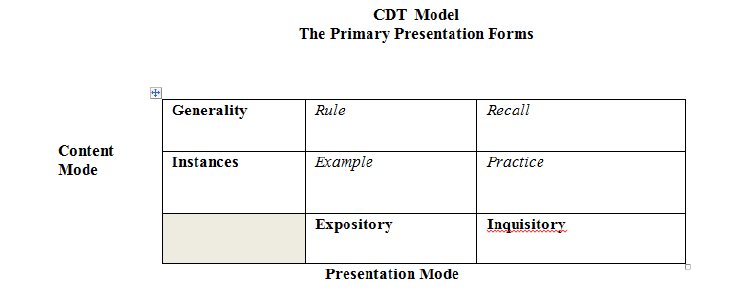Understanding Component Display Theory (CDT): A Guide to Effective Course Design
Component Display Theory (CDT) helps training providers to design courses that engage and retain learners. Click now to explore it deeply!
Component Display Theory (CDT) helps training providers to design courses that engage and retain learners. Click now to explore it deeply!
%20A%20Guide%20to%20Effective%20Course%20Design.webp)
Every great learning experience starts with effective instructional design. For training providers and course creators, designing courses that engage learners while delivering the right content is an everyday struggle. It’s natural to drift away from one aspect when focusing on the other.
One instructional design model that helps achieve the balance between content and performance is Component Display Theory (CDT). Developed by M. David Merrill in the 1970s, CDT provides a clear framework for presenting content and crafting learning activities that maximize learner understanding and retention.
With CDT, you can create interactive courses that motivate learners to log in daily for their online training sessions. In this guide, we will dig into the two dimensions of CDT to help you design an effective training course.
Component Display Theory is a prescriptive instructional design model that guides course creators on how best to present information and organize learning activities based on the type of content and what learners need to do with it.
The theory is built on the idea that instruction should be tailored based on two primary factors: the nature of the content being taught and the type of cognitive performance expected from learners.
Like other models, CDT doesn’t work on a one-size-fits-all approach. Instead, it encourages matching presentation methods and activities to specific learning objectives to ensure efficiency and effectiveness.
CDT comprises two interrelated dimensions:

The content dimension categorizes learning material into four types:
The performance dimension relates to what learners need to do with the content:
As a training provider, you should understand these two dimensions to select appropriate teaching strategies for each combination of content type and expected learner action.

CDT identifies four primary forms of instruction to present content and engage learners effectively:
For instance, teaching a procedure like call handling would involve rules (describing the steps) and practice (simulating calls). Meanwhile, facts might be taught through rules and recall exercises.
Besides the main instructional components, CDT highlights additional supports to aid learning:
These secondary forms enhance learner engagement, reduce frustration, and improve retention.
To use the Component Display Theory for course designing, you need to first analyze your learning objectives and then tailor instructional strategies to match both the type of content and the performance you expect from learners.
Here is a step-by-step guide to help you implement this learning model for course creation:
First, break down your course goals by categorizing what learners need to know and do. Suppose you’re designing an online course for new software developers to help them learn a programming language. In this case, the content and expected performance could be:
This step will set the perfect foundation for your course design.
Now, use CDT’s four primary forms, rules, examples, recall, and practice, to match appropriate tactics to each content-performance pair.
Considering our software developer course example, here is how the process should go:
Remember, these are just suggestions for an effective course design. You can add and subtract things as you like.
Don’t forget to add secondary support to your software developer course. These include, but are not limited to:

Now comes the organization of learning activities. Make sure you’ve structured everything logically, starting with foundational facts and concepts before moving to procedures and principles.
For instance, begin with an introduction to syntax and terminology (facts + rules and recall). Then, introduce data structures using conceptual explanations and example code. Once done, add some coding exercises applying procedures to guide learners.
You should also present principles with case studies and problem-solving activities to help learners deepen their mastery.

Active learner engagement is crucial. Mix informative content with interactive elements, such as alternate reading materials or videos (rules/examples), with quizzes, coding labs, and projects (recall/practice).
Keep content clear and concise to avoid cognitive overload.
By aligning instructional strategies precisely to content and learner action, you ensure that learners not only receive information but also actively process, apply, and internalize it. For software developers, this means they understand key concepts AND can write, debug, and optimize code effectively. This directly reflects the CDT framework’s goal to make instruction purposeful and performance-driven.
Component Display Theory offers a timeless yet practical framework that helps course designers create content perfectly tailored to learning goals and content nature. As a trainer provider, you can deliver engaging and empowering courses for your workforce or learners.
You can even couple these principles with advanced platforms like Coursebox as an easy way out.
Coursebox’s AI-driven training platform makes it easy to implement CDT principles. Its features can help structure courses by identifying content types and suggesting aligned instructional strategies.
For instance, automated quiz and assessment generation correspond to recall and practice components. The AI chatbot delivers real-time help and personalized feedback to enhance learner support.
Additionally, Coursebox’s rich media options, such as videos, flashcards, discussions, and SCORM integration, allow trainers to present content through diverse primary and secondary instructional forms.
Sign up for free now to explore how Coursebox can help you create dynamic and effective learning experiences.
Component Display Theory is a well-established instructional design framework that helps course creators determine how to present content effectively based on the type of information and the desired learner actions. By categorizing content and matching it with appropriate delivery methods, CDT ensures learners can absorb, apply, and discover knowledge efficiently. This makes courses more purposeful and learner-centered.
CDT categorizes content into four types: facts (basic data or terminology), concepts (categories or classes with shared attributes), procedures (step-by-step methods), and principles (cause-effect rules or general guidelines). Understanding these categories helps instructional designers choose the best method for teaching and reinforcing each type, ensuring clearer learning paths.
CDT considers three performance levels: remembering (recalling information), using (applying knowledge to familiar situations), and finding (solving new or unfamiliar problems). Instructional strategies are tailored to these levels to promote appropriate depth of understanding and skill development, making learning both comprehensive and contextual.
To apply CDT principles for course design, start by analyzing your learning objectives through the lens of CDT’s content and performance dimensions. Then, use rules, examples, recall exercises, and practice activities to build a sequence that supports your learners from basic understanding to mastery. Don’t neglect secondary supports like clear objectives, feedback, and hints to guide learners effectively throughout the course journey.
Coursebox’s AI-powered platform aligns perfectly with CDT by automating course structure based on content types and learning objectives. It generates quizzes and practice exercises that align with recall and practice strategies, and offers real-time help through AI chatbots that provide feedback and guidance. This makes applying CDT easier, faster, and scalable for creators aiming to deliver engaging, personalized learning experiences.
